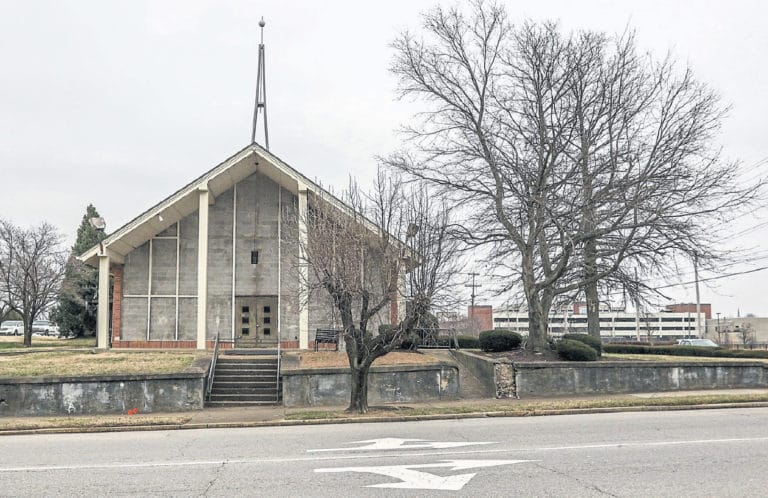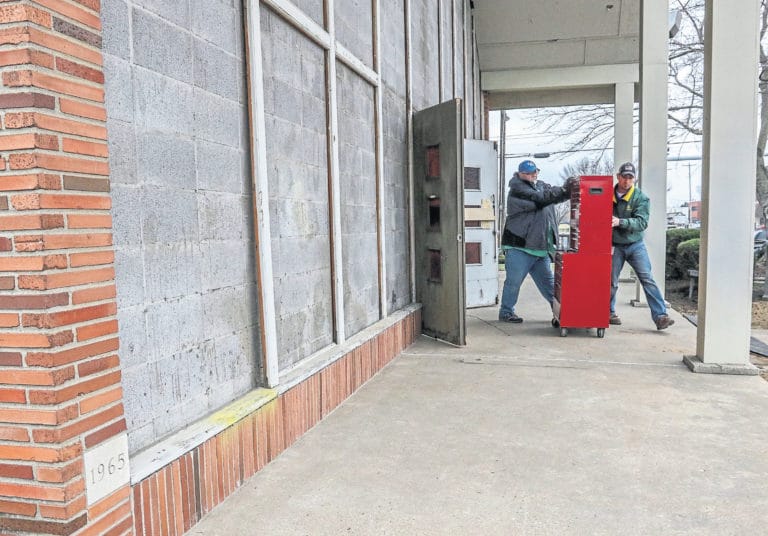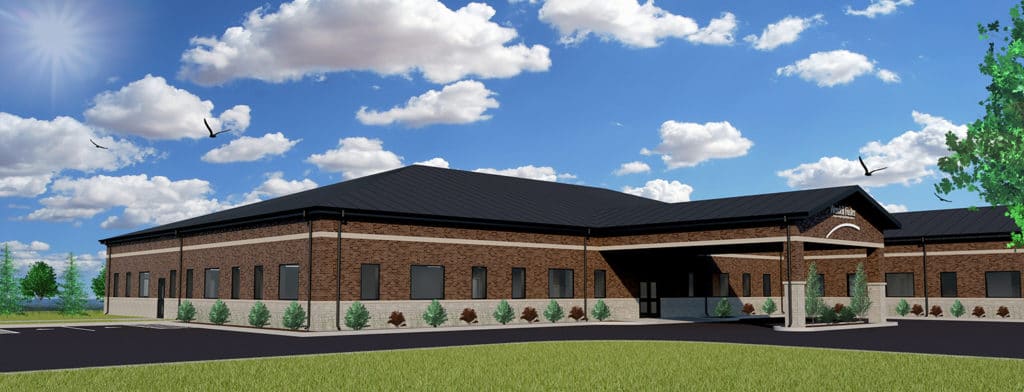By Renee Beasley Jones, Messenger-Inquirer
The Wendell Foster campus is leaning into the future.
In September, the nonprofit that serves people with disabilities released details about a three-phase project that would stretch into 2022. Early cost estimates were in the $6 million range.
Wendell Foster recently completed Phase I. A new $270,000 maintenance building now sits at Sixth and Center streets, which was an empty lot. Maintenance crews started moving into the 3,500-square-foot facility Monday.
But progress brings change.

Photo by Greg Eans, Messenger-Inquirer.com | [email protected]
The 40-by-60 foot All-Faith Chapel is being cleared out and then torn down after being used for several years as a maintenance facility at Wendell Foster.
On the campus’ opposite corner — at Ninth and Triplett streets — sits Wendell Foster’s All-Faith Chapel. Its lot is needed for Phase II, a 12,600-square-foot comprehensive outpatient rehabilitation facility estimated to cost $3.5 million.
To make room, the much-loved chapel must go. It will be razed later this month or in early February.
Wendell Foster officials know it’s a sensitive subject for some campus residents who worshipped there as children, for some past employees and for community members who pitched in to build the church during the spring of 1965.
However, for many years now, the one-time chapel has served as a maintenance facility. Instead of being home to prayers and songs of worship, it has been silent, filled with groundskeeping equipment and other tools of the trade.
Besides, Wendell Foster residents attend local churches now, which is more inclusive. Leaving campus to worship gives them an avenue for integration into their community.
“Our needs have changed over time,” said CEO Eric Scharf. “We are in a situation where the current (rehabilitation and therapy) building can only hold so much. We have a waiting list. This will allow us to bring in new technology and address more needs.”

Photos by Greg Eans, Messenger-Inquirer.com | [email protected]
Richie Purcell, left, and Chad Underhill with the maintenance department at Wendell Foster, roll a large toolbox from the All-Faith Chapel on the organization’s campus on Tuesday in Owensboro. The chapel, built in 1965, is slated to be torn down soon to make way for a new outpatient therapy building.
Building the All-Faith Chapel
The chapel was a joint effort between Wendell Foster and the Owensboro Kiwanis Club. The two groups started planning the church in October 1964.
They estimated the cost to run about $25,000 for the 40-by-60-foot brick structure. However, thanks to generous donors and voluntary labor, the building ended up costing about $13,000.
“Through the good will of literally hundreds of people, the chapel will be constructed in 24 hours of elapsed time over a period of three weeks,” the Messenger-Inquirer reported in April 1965.
More than 230 people donated 2,740 man-hours to build the chapel. They were Kiwanis members, local labor union members, parents of Wendell Foster residents, members of the nonprofit’s board of directors and the Wendell Foster Guild.
People from Indianapolis, Louisville, Paducah and other cities pitched in.
The local American Legion bought chairs. Parents of Wendell Foster residents paid for an organ. The guild purchased carpets.
Work on the 100-seat chapel started on April 24, 1965, and finished in early May. The Rev. Glendon Coppick performed the first service.
Catholic services were conducted there every Sunday morning. Protestant worship took place every Sunday afternoon. In June 1965, Wendell Foster officials continued to look for someone to lead Jewish services.
“This chapel is not only for our children, but for all handicapped people in the city,” Wendell Foster, the nonprofit’s founder, told the Messenger-Inquirer.
Loving the All-Faith Chapel
Lucille Rose, 86, of Owensboro was a teen when her mom became a Wendell Foster housekeeper and cook in 1948. In the beginning, Rose and her mom lived upstairs in Wendell and Edith Foster’s home — where the nonprofit started.
Rose followed in her mother’s footsteps. She worked many years at Wendell Foster. After the chapel was built, she took care of it from 1965 until 1977, tending to linens on the altar and cleaning between services on Sundays.
At times during an interview Wednesday afternoon, Rose cried at the prospect of the chapel’s demise.
“I know it’s progress,” she said, her voice breaking. “The building is old and needs a lot of repair.”
She knew the Fosters well and believes the couple would be proud of the nonprofit’s decades of progress.
“If the Fosters could come back, they wouldn’t believe how big Wendell Foster is now and how much it has grown,” Rose said.
Tommy Malone once lived at Wendell Foster. He now resides at the Roosevelt House.
Malone watched the community build the All-Faith Chapel in 1965, and he later worshipped there. He is saddened by the prospect of tearing it down, but he will receive outpatient therapy at the new rehabilitation facility when it’s finished.
Through an interpreter, Malone said he understands and accepts the building’s fate.
Karen Glenn has worked off and on at Wendell Foster since 1973. She attended weddings and funerals in the chapel. Also, at one time, she helped turn the chapel into the Speedway Toddlers day care for children of all abilities.
The chapel holds a special place in her heart. “I’d buy a brick as a memento — something to hold on to and say that’s part of my history.”
In her opinion, Wendell Foster officials are taking something that served people in the past — the chapel — and replacing it with something that will serve people in the future — the rehabilitation center.
Tending to the future
Currently, the names of more than 60 disabled clients wait on a list for speech, occupational and physical therapy at Wendell Foster. That number varies monthly.
The campus provides therapy to all residents, whether they are disabled or not. Demand from that segment is growing, Scharf said.
Wendell Foster officials have not released a construction timeline for the new rehabilitation facility because the project has not been put out on bids yet. Once construction begins, they expect it to take about nine months.
The state-of-the-art building will be equipped with a climbing wall and a specialized suspended “walking track” to assist physically disabled people, allowing them to walk without fear of falling. It also will feature a spacious foyer, eight bathrooms, two gyms, therapy rooms and a sound-proof room where parents can work or spend time alone while waiting for a child in therapy.
Wendell Foster’s current rehabilitation center can’t be retrofitted with new technologies, Scharf said.
As far as the chapel goes, the steeple will be saved and turned into a campus monument. And, if possible, bricks and other parts of the building may go to residents and community members who want a keepsake.
Rose said she would appreciate having something to remember the many years she enjoyed tending to the All-Faith Chapel.
“But you have to continue to progress,” she said. “If it’s going to help young people, that’s what you need. It’s not used as a chapel now anyway. Time moves on.”
Renee Beasley Jones, 270-228-2835, [email protected]
